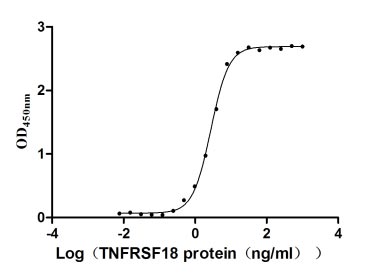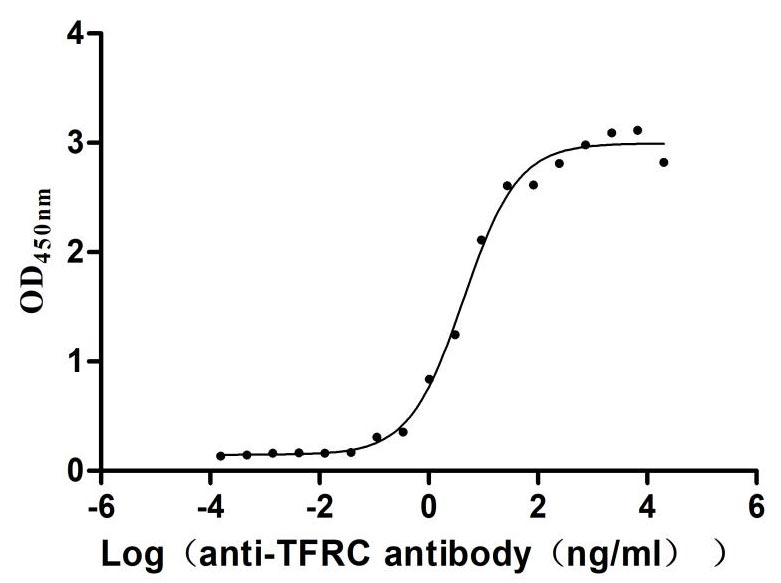Recombinant Human Claudin-14 (CLDN14), partial
-
货号:CSB-YP005494HU1
-
规格:
-
来源:Yeast
-
其他:
-
货号:CSB-EP005494HU1
-
规格:
-
来源:E.coli
-
其他:
-
货号:CSB-EP005494HU1-B
-
规格:
-
来源:E.coli
-
共轭:Avi-tag Biotinylated
E. coli biotin ligase (BirA) is highly specific in covalently attaching biotin to the 15 amino acid AviTag peptide. This recombinant protein was biotinylated in vivo by AviTag-BirA technology, which method is BriA catalyzes amide linkage between the biotin and the specific lysine of the AviTag.
-
其他:
-
货号:CSB-BP005494HU1
-
规格:
-
来源:Baculovirus
-
其他:
-
货号:CSB-MP005494HU1
-
规格:
-
来源:Mammalian cell
-
其他:
产品详情
-
纯度:>85% (SDS-PAGE)
-
基因名:CLDN14
-
Uniprot No.:
-
别名:CLDN14; UNQ777/PRO1571; Claudin-14
-
种属:Homo sapiens (Human)
-
蛋白长度:Partial
-
蛋白标签:Tag type will be determined during the manufacturing process.
The tag type will be determined during production process. If you have specified tag type, please tell us and we will develop the specified tag preferentially. -
产品提供形式:Lyophilized powder
Note: We will preferentially ship the format that we have in stock, however, if you have any special requirement for the format, please remark your requirement when placing the order, we will prepare according to your demand. -
复溶:We recommend that this vial be briefly centrifuged prior to opening to bring the contents to the bottom. Please reconstitute protein in deionized sterile water to a concentration of 0.1-1.0 mg/mL.We recommend to add 5-50% of glycerol (final concentration) and aliquot for long-term storage at -20℃/-80℃. Our default final concentration of glycerol is 50%. Customers could use it as reference.
-
储存条件:Store at -20°C/-80°C upon receipt, aliquoting is necessary for mutiple use. Avoid repeated freeze-thaw cycles.
-
保质期:The shelf life is related to many factors, storage state, buffer ingredients, storage temperature and the stability of the protein itself.
Generally, the shelf life of liquid form is 6 months at -20°C/-80°C. The shelf life of lyophilized form is 12 months at -20°C/-80°C. -
货期:Delivery time may differ from different purchasing way or location, please kindly consult your local distributors for specific delivery time.Note: All of our proteins are default shipped with normal blue ice packs, if you request to ship with dry ice, please communicate with us in advance and extra fees will be charged.
-
注意事项:Repeated freezing and thawing is not recommended. Store working aliquots at 4°C for up to one week.
-
Datasheet :Please contact us to get it.
相关产品
靶点详情
-
功能:Plays a major role in tight junction-specific obliteration of the intercellular space, through calcium-independent cell-adhesion activity.
-
基因功能参考文献:
- This study suggested considerable genetic heterogeneity in the causation of hearing loss in Dhadkai. Recessive mutations were observed in at least three genes causing hearing loss: OTOF (p.R708X), SLC26A4 (p.Y556X) and CLDN14 (p.V85D). Mutation p.R708X appeared to be the major cause of hearing impairment in Dhadkai. PMID: 29434063
- CLDN14 might not be a major causative gene for NSHL in Chinese populations, which would contribute to fully understanding the genetic cause of NSHL in the East Asian populations PMID: 29447821
- Our data suggest that children with the INSM1 binding site within the CLDN14 risk haplotype have a higher likelihood of hypercalciuria and kidney stones. Enhanced CLDN14 expression may play a role in the pathophysiology of their hypercalciuria. PMID: 28229505
- All hearing impaired individuals, including the proband, are homozygous for a pathogenic variant of CLDN14, but this only explains the deafness. PMID: 27629923
- Extensive clinical recruitment and targeted screening suggest that CLDN14 p.(Ala163Val) represents a major founder variant for prelingual sensorineural hearing loss in the Newfoundland population. PMID: 27838790
- CLDN14 is a novel direct target of EZH2-mediated H3K27ME3 and plays role in EZH2-H3K27ME3-mediated hepatocellular carcinoma aggressiveness. PMID: 27207647
- The rs170183 was correlated with a decline in claudin 14 expression in both lymphoblastoid cell lines and T cells. PMID: 26842849
- Rs1801725 (Ala986-Ser), rs1042636 (Arg990Gly) of CaSR gene and rs219778, rs219780 (Thr229Thr) of CLDN14 gene were significantly associated with kidney stone disease in patients from the Eastern part of India. PMID: 26107257
- Claudin 14 expression was up-regulated in gastric cancer. PMID: 24325792
- Data suggest a possible role for Claudin14 in urinary calcium excretion. PMID: 23991001
- CLDN14 mutations can contribute to the aetiology of childhood/congenital deafness in Moroccan patients. PMID: 23590985
- Human Cldn-8 and -14 were shown to convey Clostridium perfringens enterotoxin-mediated cytotoxicity at pathophysiologically relevant concentrations of this toxin, although ~2-to-10-fold less efficiently than Cldn-4. PMID: 23322640
- OPRM1 genetic polymorphisms are associated with the plasma concentration of cotinine in a Taiwanese MMT cohort. Carriers with the major allele of SNP rs1799971 had a higher plasma cotinine concentration. PMID: 23235333
- The hearing loss due to novel CLDN14 mutations is prelingual, severe-to-profound with greater loss in the high frequencies. PMID: 22246673
- The CLDN14 promoter is activated by Trichostatin A (TSA) treatment according to promoter reporter assays in HEK 293 cells. PMID: 20494980
- Individuals with mutations of CLDN14 may have different degrees of hearing loss and the loss is greater at higher frequencies. PMID: 20811388
- The palmitoylation of claudin-14 is required for efficient localization into tight junctions but not stability or strand assembly. PMID: 15769849
- The ability of CLDN14 to be recruited to these junctions is crucial for the hearing process. PMID: 15880785
- Common, synonymous variants in the CLDN14 gene that associate with kidney stones, were discovered. PMID: 19561606
显示更多
收起更多
-
相关疾病:Deafness, autosomal recessive, 29 (DFNB29)
-
亚细胞定位:Cell junction, tight junction. Cell membrane; Multi-pass membrane protein.
-
蛋白家族:Claudin family
-
组织特异性:Liver, kidney. Also found in ear.
-
数据库链接:
HGNC: 2035
OMIM: 605608
KEGG: hsa:23562
STRING: 9606.ENSP00000339292
UniGene: Hs.660278
Most popular with customers
-
Recombinant Human Tumor necrosis factor receptor superfamily member 18 (TNFRSF18), partial (Active)
Express system: Mammalian cell
Species: Homo sapiens (Human)
-
Recombinant Human Carcinoembryonic antigen-related cell adhesion molecule 6 (CEACAM6) (Active)
Express system: Mammalian cell
Species: Homo sapiens (Human)
-
Recombinant Human Tumor-associated calcium signal transducer 2 (TACSTD2), partial (Active)
Express system: Mammalian cell
Species: Homo sapiens (Human)
-
Recombinant Human Transferrin receptor protein 1 (TFRC), partial (Active)
Express system: Mammalian cell
Species: Homo sapiens (Human)
-
Recombinant Human Serotransferrin(TF) (Active)
Express system: Mammalian cell
Species: Homo sapiens (Human)
-
Recombinant Human C-C chemokine receptor type 6(CCR6)-VLPs (Active)
Express system: Mammalian cell
Species: Homo sapiens (Human)
-
Recombinant Human Kidney-associated antigen 1(KAAG1) (Active)
Express system: E.coli
Species: Homo sapiens (Human)
-
Recombinant Macaca fascicularis Dipeptidase 3(DPEP3) (Active)
Express system: Mammalian cell
Species: Macaca fascicularis (Crab-eating macaque) (Cynomolgus monkey)




















